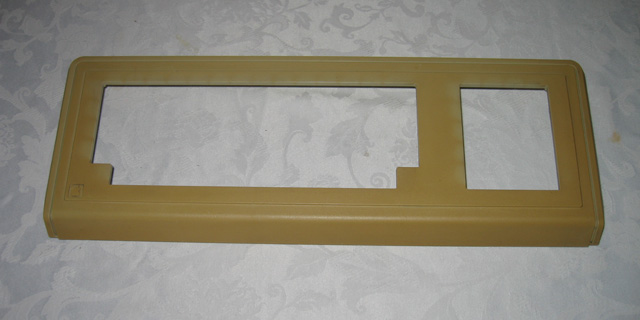| Tweet |
De-yellowing computers with laundry whiteners (i.e. sodium percarbonate) only
Introduction
While Retr0bright pastes and soaks for yellowed plastics is now pretty well known, people are still experimenting with more convenient and cheaper ways to do this. This blog post reports on one of these methods.
Sodium percarbonate (i.e. laundry activator) only
Retr0bright can take two forms. A paste for applying to cases with a brush, or a soak to immerse cheddar-cheese coloured pieces in. In both cases a dilute solution of hydrogen peroxide is used together with an activator to boost performance. That activator can be one of the many common laundry whiteners. It just has to contain sodium percarbonate, a compound that itself releases hydrogen peroxide.
Straight hydrogen peroxide can be expensive, hard to get and dangerous to handle when concentrated. This has lead to people experimenting with JUST laundry whiteners, at least for retr0bright soaks. Some success with this was reported on the comments section on one of my blogs (click the comments section if you visit) and further on the Vintage computer forums. I thought I'd give the method a try on a couple of very yellowed Lisa keyboard cases I had.
Method
I used a common laundry whitener here called "Oxy-Magic". This contains 35% sodium percarbonate, which is the most concentrated I could find. Some other products had 20 or 25%.
I mixed 500g Oxy-Magic with 5 liters of warm water in bucket until most was dissolved. I then made up the volume to an estimated 15-20 liters with cold water in a small plastic wheelbarrow. I used the wheelbarrow for two reasons. First, it was shallow and the Lisa keyboard cover is long. Second, I could easily move it around our property to areas of full sunlight. We have lots of trees around us, and I needed to chase the patches of sunlight as the day progressed.
After filling the wheelbarrow I placed a Lisa Keyboard top panel into this mixture. The keyboard was weighed down with lots of blu-tack underneath so it stayed under the water. For the necessary UV exposure I then put the wheelbarrow and it's contents outside in the New Zealand summer sun for about 8 hours. There was a lot of foaming initially. I skimmed most of this off so that light could get through to the keyboard under the water. I couldn't remove all of the foam though as it kept forming so a thin layer remained on the surface.

Figure 1. The de-yellowing barrow
I processed two keyboards on two consecutive days this way. The first day was partly cloudy so all up I reckon only about 4 hours full sunlight. The second day was sunnier and exposure was about 6 hours.
Results
Very good indeed. The before and after pictures below are from the first day soak. The second cover on the second day showed a similar result.

Figure 2. One very yellowed Apple Lisa keyboard case

Figure 3. One much lighter Apple Lisa keyboard case after 4 hours sunlight and a 3% Oxy-Magic soak
I wouldn't say de-yellowing was complete in these trials but certainly it was 95% there, which was enough for me. This wasn't a comparative trial, so I can't compare this technique with the standard hydrogen peroxide soak.
Unknowns
While the result was good, there are still a lot of unknowns. For example could I have used a lower concentration? Would a higher concentration been better? Would giving each keyboard two 8 hour soaks (i.e. over two days) with a fresh batch of whitener between have been better? There was no sign of blooming, but is there a risk of this on different kinds of plastics? Just how much UV did the foam cut down, or was it getting through anyway? New Zealand and Australia sunlight has very high levels of UV. Are the results the same in other parts of the globe?
These are questions some good comparative trials could answer.
Reflections
My college chemistry is years behind me so I haven't worked out just how much hydrogen peroxide is released per gram of sodium percarbonate. It seems to be enough for a decent de-yellow though and you get a very clean piece of plastic to boot.
Hydrogen peroxide costs me $15 for 6% 500ml solution. Oxy-Magic costs me about $4 for 500g. Now it is possible that under the strong New Zealand sun four dollars worth of my 6% H2O2 (about 125mls) in 15-20 litres plus a touch of laundry activator (i.e. traditional retr0bright) MIGHT give a similar result as the above. That's a very weak solution though and I'd be surprised if it did. Even if this was the case, laundry whitener is much easy to get hold of and safer to handle than my usual supply of H2O2 so I'll be using just the former for soaking larger items from now on. The downside is lots of foaming. Some of this will be from the reaction itself but much of it will be from the other detergents in the whitener.
That said, I'll still be using traditional retr0bright paste for yellowed items that have labels or dark areas. These can be damaged by exposure to H2O2 and the paste allows me to paint around them. However, who is to say someone won't come up with masking materials (wax, silicon spray?) to protect these areas as well.
Many thanks to the guys who alerted me to this and posted messages about it. Homebrew science marches on...
Tez
21st January, 2011
| Tweet |